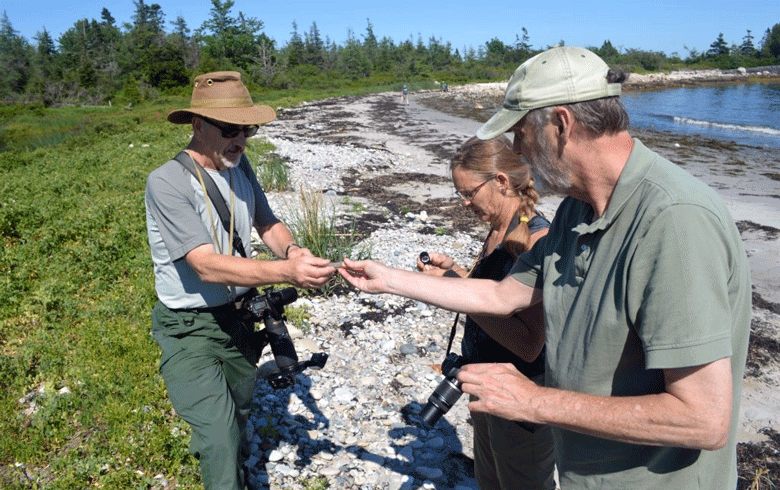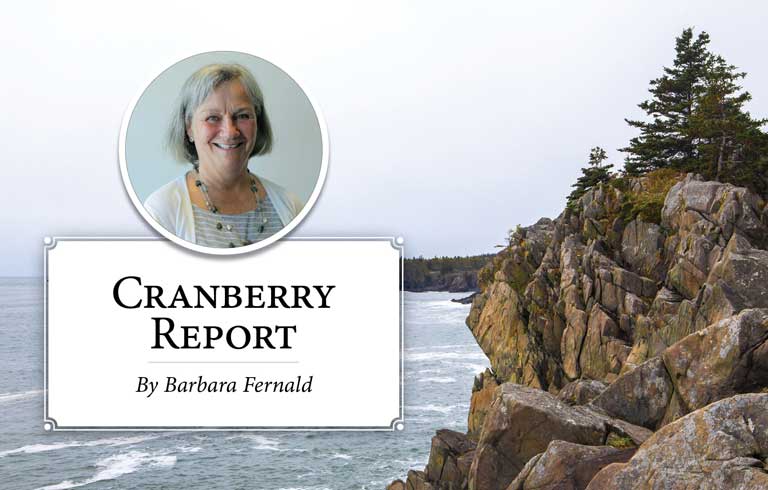On Islesboro, there are some really big spiders. So startlingly big, that a legend has grown up in recent decades about an “up-island spider” living on the upper end of the island and rumored to be as large as 8 inches from toe to toe. It has red eyes. Its footsteps can be heard pattering at night. More down-to-earth versions of the legend speculate it’s a species of particularly large wolf spider unique to the island.
Hmm.
It’s true that wolf spiders are abundant in Maine, including along the coast. You can see them pretty readily, actually. The tiny beings darting around sun-bleached sandy beaches might seem like house flies or sand fleas, but they’re more likely to be thin-legged wolf spiders, of the genus Pardosa.
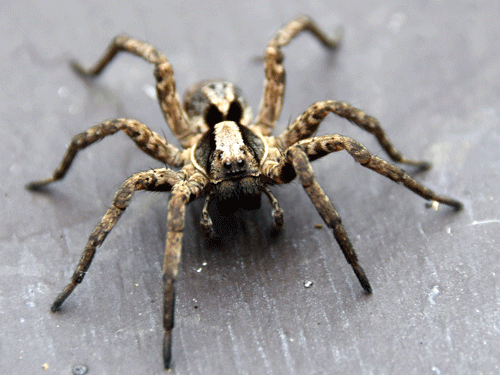
Some spidering colleagues and I saw them in copious numbers one summer awhile back on the beach at Petit Manan National Wildlife Refuge. What species of Pardosa we were seeing was nigh-on impossible to tell. We would have to catch a couple, bring them back to the lab, and subject them to microscope procedures if we wanted to find out.
Our expedition was part of a long Downeast tradition, really. Many, probably most of the studies done on spiders in Maine have taken place along the Downeast coast, and our weeklong course in spider identification and biology at the Eagle Hill Institute in Steuben was an extension of that long-running research.
Starting around the turn of the 20th century, naturalists began inventorying the arthropod populations on and around Mount Desert Island. Their lists included insects, spiders, and other tiny invertebrates. By then it was well-established taxonomic fact that spiders are not insects.
Insects have six legs, three body parts, sometimes wings, sometimes antennae, and sometimes a stinger. Spiders have eight legs, two body parts, no wings, no antennae, and no stinger. And while there are aquatic insects, there are no fully aquatic spiders—just spiders who happen to live along rivers and ponds, cobble beaches, and salt marshes. The kind of habitat you might encounter on, say, the upper end of Islesboro. Some of these semi-aquatic spiders can run across the surface of the water, and a few are big enough to catch minnows and drag them ashore to eat.
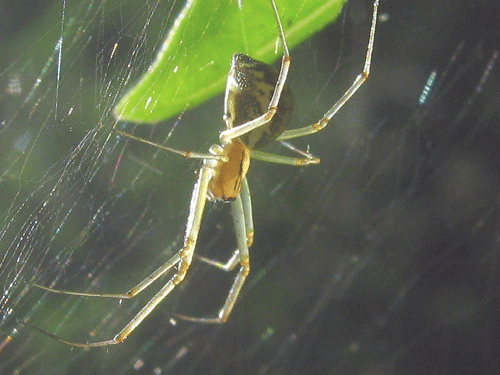
The first substantial list of spider species found in Maine was part of the Biological Survey of the Mount Desert Region, by William Procter, published in 1946 following his inventory of invertebrates there in the 1920s, ’30s, and ’40s. The next comprehensive list of spiders in Maine was Spiders (Arachnida: Araneae) of Milbridge, Washington County, Maine by Daniel T. Jennings and Frank Graham, Jr., published in 2007, based on their collections made from 1991 to 2005 in Milbridge.
In October 2020, the Checklist of Maine Spiders, compiled by Jennings and former state entomologist Charlene Donahue, and listing 677 spider species verified in Maine, was published by the Maine Forest Service. Nowhere in the Checklist is there a mention of the up-island spider.
Jennings, Maine’s foremost spider expert who passed away in September 2020, made studies of spiders more or less throughout Maine, from Washington County blueberry barrens and the Moosehorn Wildlife Refuge to the northern and central woods. But while spiders are abundant everywhere, particularly interesting discoveries have come from the numerous coastal studies.
Graham, while collecting spiders around his home in Milbridge in 1991, found a spider he could not identify. With Jennings’ help, he figured out it was a European hammock spider, aka Linyphia triangularis—never before identified in North America. Subsequently nicknamed “Linytri” by Graham and Jennings, it was matched to an unidentified specimen found in Brooksville in 1983, and they determined it to be an invasive species of sheetweb weaver recently arrived somehow in the vicinity of MDI.
And not without effects. Studies found that where the European hammock spider is abundant, as at Acadia, other native sheetweb weavers such as the hammock spider and filmy dome spider have become scarce. Meanwhile in places where Linytri is not widespread, such as the Cobscook Bay area in the early 2000s, the native sheetweb weavers remain abundant.
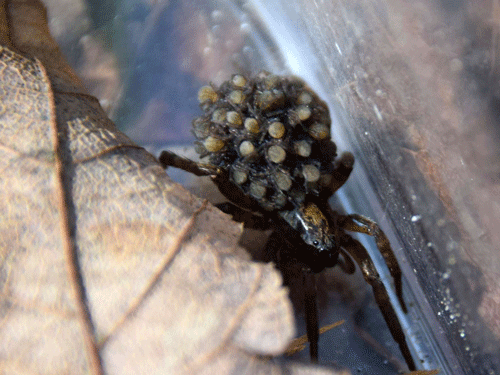
In 2002, researchers working in Winter Harbor found a dewdrop spider (the cobweb weaver Neospintharus trigonum) eating a female Linytri in her own web. The dewdrop spider was already known to be a kleptoparasite, or a spider that steals prey from other spiders. Now, apparently, it was eating the web owners themselves.
The implications of this have yet to be sorted out, but it is not always smooth sailing for the invasives. Jennings had also found a juvenile dewdrop spider in a L. triangularis web farther southwest in Pittston in 1999, suggesting the invasive spider’s Maine range was affecting ecologies beyond the Downeast coast.
In our Steuben searches, we found at least one individual from most of the spider families listed in Jennings and Graham’s Milbridge study—jumping spiders, cobweb weavers, hackledmesh weavers, crab spiders, cellar spiders, orbweavers, ground spiders, and more. Wolf spiders were by far the most numerous spiders in the Milbridge study.
Those found Downeast range in size from tiny to startlingly large. Jennings and Graham found Pirata minutus individuals, which can be as small as .12 inch in body length, along the shore, and Trochosa terricola, whose females can exceed a half inch in body length, inhabiting mainly leaf litter and salt marsh areas.
We found mother wolf spiders on the stony shoreline carrying their round white egg sacs underneath their spinnerets. Others had their newly hatched spiderlings riding on their backs—as reported of the up-island spider. The Schizocosa genus of wolf spiders, with body lengths typically around a quarter inch, is found around salt marshes, among other places. Trochosa ruricola, found abundantly along Narraguagus Bay by Jennings and Graham, is another invasive from Europe. It arrived sometime before the 1990s and may be displacing its native cousin, Trochosa terricola, on offshore islands.
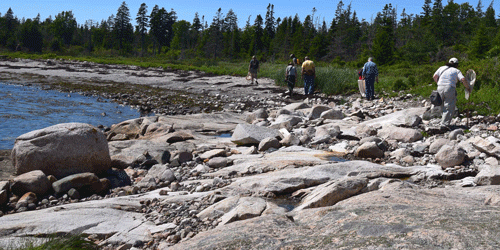
When I asked Jennings a few years ago what might be the most commonly seen spider in Maine, he said, after a few moments’ thought, “Maybe Pardosa.” And in fact, the thin-legged wolf spiders we saw darting around the beach at Petit Manan Wildlife Refuge might well have been Pardosa moesta—the most numerous species in the Milbridge study.
Most Pardosa are roughly medium-sized wolf spiders, so maybe they can be ruled out for Islesboro’s up-island spider. Schizocosa and Trochosa are often larger, but no one, even when startled, would be apt to make their leg spans 8 inches. There are some pretty big orbweaving spiders in Maine, particularly the barn spider, aka Araneus cavaticus, the model for E.B. White’s Charlotte whom he fashioned at his home in Brooklin.
Among the photos I’ve seen online of up-island spiders, some are clearly wolf spiders, which makes sense in the lore because wolf spider mothers carry their kids on their backs. Most of the photos, though, appear to be of fishing spiders. This makes even more sense, because fishing spiders (also called wharf, dock, or raft spiders) are just about the largest spider commonly seen in Maine. They live much of their lives hunting near, on, and in water. They sometimes wander into human habitations. I woke one night to see a huge female Dolomedes tenebrosus on the bedroom wall a few inches from my face.
It is extremely unlikely that a unique spider species lives only on one end of Islesboro and very likely that most sightings of the up-island spider are of fishing spiders, perhaps, as an arachnids specialist assured a journalist some years ago, Dolomedes tenebrosus.
And just to reassure you: Even the largest spiders you’re apt to see among the boulders, beaches, and backwoods of Maine’s coast are extremely unlikely to bite you, whether wolf, fishing, orbweaving, or other kind. Almost all spiders run away as their first defense, and few have jaws strong enough to break human skin.
They may seem scary because they look like little monsters, but spiders are the guardians of your garden. And, as it were, the beach.
Dana Wilde is the author of A Backyard Book of Spiders in Maine available from North Country Press. www.northcountrypress.com/a-backyard-book-of-spiders-in-maine.html
